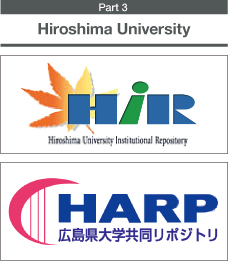
Fumiyo Ozaki
(Chief, Planning and Coordination and Institutional Repository Sections,
Library Information Planning Group, Hiroshima University Library)

At Hiroshima University, there are two institutional repositories that could be called in some sense “ours.”
One is the Hiroshima University Institutional Repository (HiR); this collects and publishes the results of research at Hiroshima University. The other is the Hiroshima Associated Repository Portal (HARP), a joint or shared repository operated by the members of the Hiroshima Association of University Libraries (HAUL). Hiroshima University is involved in the running of HARP because its library is the secretariat of HAUL.
In October 2006 (the month that HiR became fully operational), HARP was launched as a trial project in which eight institutions in Hiroshima Prefecture would jointly operate a single prefecture-wide repository. At the time, only about a dozen Japanese universities had institutional repositories (IRs), and even Hiroshima University, which had proposed the experiment, had only just brought its own IR into service and was hardly up to speed. Thus, at the outset, both Hiroshima University and the HARP participants had only the vaguest idea of whether a joint program among smaller institutions was truly possible.
However, we equipped ourselves with practical know-how by holding a series of training sessions and studying the available software. In July 2007, from these trial beginnings on a volunteer basis, the project became an official undertaking of HAUL, and in April 2008, HARP formally opened to the public with eleven of the prefecture’s institutions participating; their number has since grown to twelve.
Building a joint IR by sharing the technology and costs is seen as an effective way to bring a repository within reach of institutions too small to readily create their own, thus expanding the realm of open access. The threshold for building IRs is growing lower year by year as the necessary technology and know-how become more widely available, but I think there was another factor, besides technology- and cost-sharing, behind HARP’s start in 2006. That factor was the forward-looking attitude of Hiroshima’s institutions, which, when faced with a tight budget and staff cuts, decided to take on a new venture and find a new goal. HARP began as a study group, and it continues to hold regular study meetings to share information and strengthen mutual ties. These meetings have supplied the momentum as we laid the groundwork and then brought HARP into continuous operation.
Hiroshima University’s role in HARP is a supporting one, but our involvement has helped us gain the skills needed to deal not only with the novel challenges of a shared repository, but also with the issues presented by IR management itself. These skills are proving valuable in running HiR, and the two repositories thus have a mutually beneficial relationship, each helping to improve the other.
Based on the results achieved with HARP, in the joint repository project “ShaRe,” launched in 2008 under an NII CSI commission and headed by Hiroshima University, we are now working with a number of other universities to encourage the creation of shared repositories nationwide by offering problem-solving and personnel training in the areas of systems and management. As of 2010, shared repositories are operational in eight prefectures: Yamagata, Niigata, Saitama, Fukui, Okayama, Hiroshima, Yamaguchi, and Okinawa, and a growing number of regions are studying the possibility of creating their own. These shared repositories account for a very high proportion of online access to the research results of small and medium-sized institutions; about half of the local public universities and private universities that have institutional repository operations of any kind, and almost 100 percent of the junior colleges and technical colleges that have such operations, are members of shared repositories.
With the work of creating them forming a nucleus, shared repositories can be said to contribute to strengthening the local ties of academic institutions and revitalizing community activities. As the technology advances, shared repositories will likely take on a variety of different forms, but I believe that community activities at the local level will remain essential to the sustained operation of IRs.
We hope to continue expanding the circle of “our repositories (IR Community)” in the future. |

